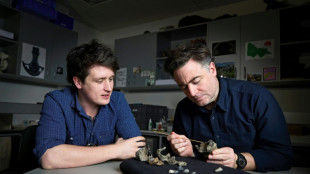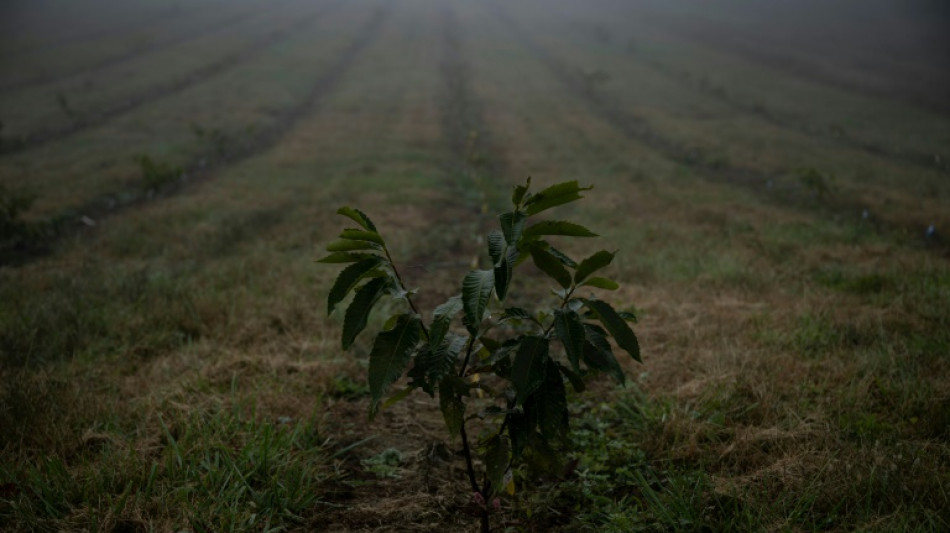
-
 North Korea denies removing border loudspeakers
North Korea denies removing border loudspeakers
-
Despite risks, residents fight to protect Russian national park
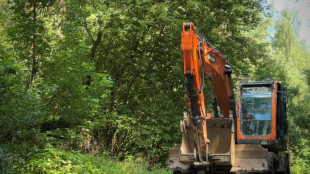
-
 Asian markets mixed as bitcoin surges to new high
Asian markets mixed as bitcoin surges to new high
-
War-weary Ukrainians find solace by frontline lake
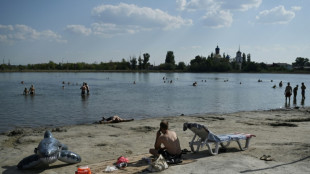
-
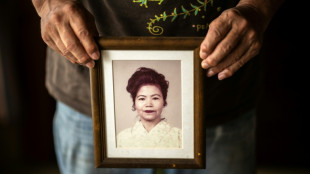 Okinawa a reluctant host for US troops 80 years after WWII
Okinawa a reluctant host for US troops 80 years after WWII
-
Alonso's Real Madrid start La Liga with fresh energy

-
 Liverpool splash out to secure status as Premier League's top dogs
Liverpool splash out to secure status as Premier League's top dogs
-
Hong Kong court postpones closing arguments in Jimmy Lai trial

-
 Top Japanese fighter retires to support comatose boxer brother
Top Japanese fighter retires to support comatose boxer brother
-
Boars, Butterflies or Bees? Public to name Papua New Guinea's NRL team

-
 Defending champions Sinner, Sabalenka reach Cincinnati quarters
Defending champions Sinner, Sabalenka reach Cincinnati quarters
-
Bolivia presidential hopefuls make last push for votes

-
 Trump orders space regulations eased in win for Musk
Trump orders space regulations eased in win for Musk
-
Trump warns of make-or-break chance with Putin as pressure mounts

-
 From Snoop Dogg to Tom Brady, stars flock to English second-tier clubs
From Snoop Dogg to Tom Brady, stars flock to English second-tier clubs
-
Inside Trump's 'Alligator Alcatraz': detainees allege abuse in a legal black hole
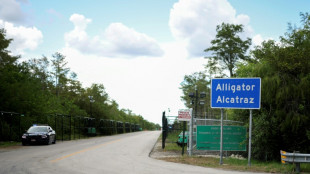
-
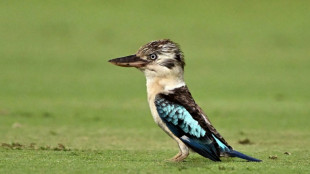 Scientists find surprising sex reversal in Australian birds
Scientists find surprising sex reversal in Australian birds
-
Taylor Swift sets October release for new album

-
 Sinner, Sabalenka sail into Cincinnati quarter-finals
Sinner, Sabalenka sail into Cincinnati quarter-finals
-
Oh carp: UK's Lammy on the hook after fishing with Vance without licence
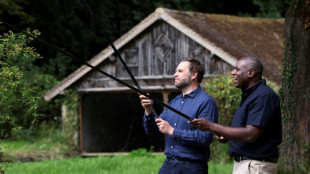
-
 Sinner shrugs off rain to dispatch Mannarino in Cincinnati
Sinner shrugs off rain to dispatch Mannarino in Cincinnati
-
Tainted fentanyl blamed for 87 hospital deaths in Argentina

-
 Eyeing robotaxis, Tesla hiring New York test car operator
Eyeing robotaxis, Tesla hiring New York test car operator
-
NBA approves $6.1bn sale of Boston Celtics

-
 PSG beat Tottenham on penalties to win UEFA Super Cup after late comeback
PSG beat Tottenham on penalties to win UEFA Super Cup after late comeback
-
Cowboys owner Jones says experimental drug saved him after cancer diagnosis

-
 Striking Boeing defense workers turn to US Congress
Striking Boeing defense workers turn to US Congress
-
PSG beat Tottenham on penalties to win UEFA Super Cup

-
 Hong Kong court to hear closing arguments in mogul Jimmy Lai's trial
Hong Kong court to hear closing arguments in mogul Jimmy Lai's trial
-
US singer Billy Joel to sell off motorcycles due to health condition

-
 Barcelona's Ter Stegen validated as long-term injury by La Liga
Barcelona's Ter Stegen validated as long-term injury by La Liga
-
Storm makes landfall in China after raking Taiwan as typhoon
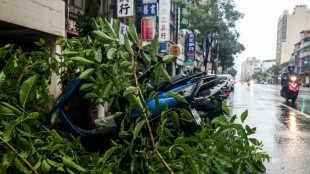
-
 Colombia buries assassinated presidential candidate
Colombia buries assassinated presidential candidate
-
Zverev finishes overnight job at Cincinnati Open

-
 Bukele critics face long exile from El Salvador homeland
Bukele critics face long exile from El Salvador homeland
-
McIlroy 'shot down' suggestion of Ryder Cup playing captain role

-
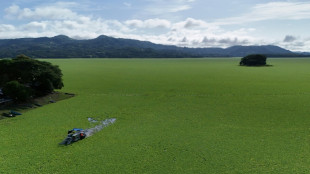 'Water lettuce' chokes tourism, fishing at El Salvador lake
'Water lettuce' chokes tourism, fishing at El Salvador lake
-
Peru's president signs military crimes amnesty bill into law

-
 At least 26 migrants dead in two shipwrecks off Italy
At least 26 migrants dead in two shipwrecks off Italy
-
Root says Warner jibe 'all part of the fun' heading into Ashes

-
 Plastic pollution treaty talks in disarray
Plastic pollution treaty talks in disarray
-
Trump eyes three-way meeting with Putin, Zelensky

-
 'Viable' chance for Ukraine ceasefire thanks to Trump: UK PM
'Viable' chance for Ukraine ceasefire thanks to Trump: UK PM
-
Vance visits US troops during UK trip

-
 Premier League has no say on delay over Man City charges, says chief exec
Premier League has no say on delay over Man City charges, says chief exec
-
Trump names Stallone, Strait among Kennedy Center honorees

-
 Israeli military says approved plan for new Gaza offensive
Israeli military says approved plan for new Gaza offensive
-
Europeans urge Trump to push for Ukraine ceasefire in Putin summit

-
 Stocks extend gains on US rate-cut bets
Stocks extend gains on US rate-cut bets
-
Venus Williams receives wild card for US Open singles


For blight-ridden American chestnut tree, rebirth may be in offing
The American chestnut tree, once a regal pillar of forests across the eastern United States, is on life support, struggling to survive.
"These look like death," said Vasiliy Lakoba, research director for the American Chestnut Foundation (ACF), which has been working since the 1980s to resurrect the species.
He pointed to a patch of stunted shrubs, chestnut trees that were a far cry from the noble, erect chestnut trees of yesteryear.
Settlers along the US eastern seaboard relied on abundant chestnut trees to feed their hogs, their children and themselves. Chestnuts made up about 50 percent of hardwood forests in much of the eastern seaboard, and the wood was ideal for building.
But then came a terrible fungus, identified in 1904 at the Bronx Zoo on a tree from Japan. In less than three decades, millions of American chestnut trees had perished. It has been considered the greatest tragedy in the history of American forestry.
"The devastation was so fast," said Lakoba, referring to "ghost forests."
Today, only a few rare specimens still survive to adulthood in the wild.
- 'Tall and straight' -
Nestled in the Appalachian Mountains, the foundation's main laboratory farm spans 36 hectares (almost 90 acres) in Virginia and includes tens of thousands of trees.
Workers use a crane to harvest the burrs, or spiny prickly shells that cover the nuts, then take them to a shed to be studied and used for future planting.
"It's like picking apples, but with pricks," laughed Jim Tolton, a technician on the farm, during a chestnut harvest day in early October.
Before the disease, the American chestnut tree "grew tall and straight through the forest, fighting for light," Lakoba said.
But the blight causes cankers to appear on the branches and stems of the American chestnut tree.
Blighted trees grow other branches here and there, giving them a bushy appearance, instead of maintaining a tall, straight shape.
No cure has yet been found to stop the spread.
- Hybrids and GMOs -
Finding a way to fight the blight is precisely the mission of ACF.
To do this, two main research avenues are under investigation: The first, which has been in place for years, consists of crossing an American chestnut tree with other species that already show some resistance to the fungus, such as the Chinese chestnut tree.
A first specimen is produced from this hybridization, before it is crossbred again with an American chestnut tree, then once again -- all in order to preserve as much of the original genetic characteristics as possible. The current hybrid has 15/16ths of the genetic makeup of an American chestnut tree -- while ideally acquiring the resistance of the Chinese chestnut tree.
One of the main drawbacks with these hybrids, explained Lakoba, "is that blight resistance and susceptibility have turned out to be a genetically much more complex phenomenon than previously thought."
ACF researchers have not abandoned their crossbreeding efforts. But a second avenue of research has opened up: genetic modification.
Working on a transgenic version of the American chestnut tree, researchers at the State University of New York at Syracuse have developed a specimen that shows very promising early results of disease resistance, according to Lakoba, who is collaborating with the researchers.
Combining crossbreeding with genetic modification might yield better results, he said.
- 'Keep chipping away' -
Once a resistant specimen has been developed, the time will come for the Herculean task of reintroducing the tree to an American landscape deeply altered by more than a century of development.
"So much has changed in terms of climate, in terms of invasive species, in terms of pollution, habitat change, land use, change, soil loss and erosion, that it really isn't the same world from 100 years ago," Lakoba said.
Not only has the landscape been altered, Lakoba said, climate change adds another wildcard to whether the American chestnut can ever prosper again.
"Overall, there will be more pests, there will be more diseases," he said.
Any revival of the American chestnut may be decades -- or centuries -- away.
"This is definitely at least a couple centuries of a mission going forward. And from there, I think we just keep chipping away at it," Lakoba said.
But he is hopeful that scientific advances are on the side of the American chestnut.
"We see it really as a matter of time."
S.Barghouti--SF-PST

